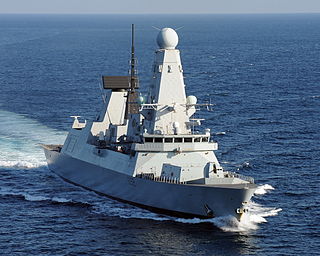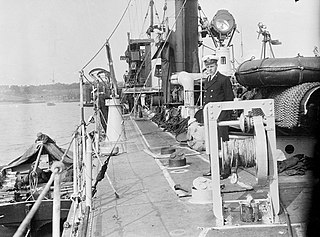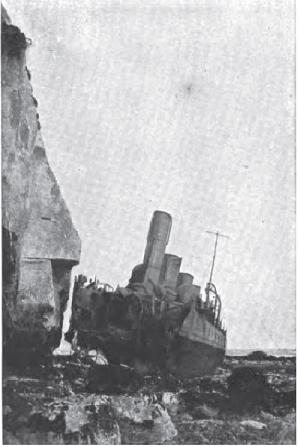
The Type 45 destroyer, also known as the D or Daring class, is a class of six guided-missile destroyers built for the United Kingdom's Royal Navy in the early 21st century. The class is primarily designed for anti-aircraft and anti-missile warfare and is built around the PAAMS air-defence system using the SAMPSON Active electronically scanned array (AESA) and the S1850M long-range radars. The first three destroyers were assembled by BAE Systems Surface Fleet Solutions from partially prefabricated "blocks" built at different shipyards; the remaining three were built by BAE Systems Maritime – Naval Ships. The first ship in the Daring class, HMS Daring, was launched on 1 February 2006 and commissioned on 23 July 2009.

Swan Hunter, formerly known as Swan Hunter & Wigham Richardson, is a shipbuilding design, engineering, and management company, based in Wallsend, Tyne and Wear, England.

HMS Eskimo was a Tribal-class destroyer, Eskimo served throughout the Second World War, seeing action in Norway, the Mediterranean, the English Channel and in Burma. After the war Eskimo was used as an accommodation and headquarters ship, finally being used as a practice target before being scrapped in 1949.

HMS Daring is the lead ship of the Type 45 or Daring-class air-defence destroyers built for the Royal Navy, and the seventh ship to hold that name. She was launched in 2006 on the Clyde and conducted contractor's sea trials during 2007 and 2008. She was handed over to the Royal Navy in December 2008, entered her base port of Portsmouth for the first time in January 2009 and was formally commissioned on 23 July 2009. As the lead ship of the first destroyer class built for the Royal Navy since the Type 42 in the 1970s, she has attracted significant media and public attention. Her name, crest and motto are a reference to the Roman youth Gaius Mucius Scaevola, famed for his bravery.

The Zeebrugge Raid on 23 April 1918, was an attempt by the Royal Navy to block the Belgian port of Bruges-Zeebrugge. The British intended to sink obsolete ships in the canal entrance, to prevent German vessels from leaving port. The port was used by the Imperial German Navy as a base for U-boats and light shipping, which were a threat to Allied control of the English Channel and southern North Sea. Several attempts to close the Flanders ports by bombardment failed and Operation Hush, a 1917 plan to advance up the coast, proved abortive. As ship losses to U-boats increased, finding a way to close the ports became urgent and the Admiralty became more willing to consider a raid.

The C class as designated in 1913 was a heterogeneous group of torpedo boat destroyers (TBDs) built for the Royal Navy in the late-1890s. They were constructed to the individual designs of their builders to meet Admiralty specifications. The uniting feature of the class was a top speed of 30 knots, a "turtleback" forecastle and that they all had three funnels. The funnels were spaced equidistantly and were of equal height, but the central one was thicker.

HMS Laforey was the lead ship of her class of destroyer built for the Royal Navy. Launched a year before the First World War began, she was attached to the Dover Patrol. Laforey saw action in several engagements with German torpedo boats, including the Battle off Noordhinder Bank and the action of 17 March 1917. Laforey was sunk in 1917 by a British mine after escorting several freighters to France. She was named for Francis Laforey, captain of HMS Spartiate at the Battle of Trafalgar in 1805.
Six ships of the British Royal Navy have been named HMS Flirt:

HMS Viking was a Tribal-class destroyer of the Royal Navy launched in 1909 and sold for scrap in 1919. She was the only destroyer ever to have six funnels.

HMS Cossack was a Tribal-class destroyer of the Royal Navy launched in 1907 and sold in 1919.

HMS Tartar was a Tribal-class destroyer of the Royal Navy launched in 1907 and sold in 1921. During the First World War, she served in the North Sea and the English Channel with the 6th Destroyer Flotilla.

HMS Doon was a Hawthorn Leslie type River-class destroyer ordered by the Royal Navy under the 1903 – 1904 Naval Estimates. Named after the River Doon in western Scotland, she was the first ship to carry this name in the Royal Navy.

The Star-class destroyer was a class of eight destroyers that served in the Royal Navy: Bat, Crane, Chamois, Fawn, Flirt, Flying Fish, Star and Whiting, were all three-funnelled C-class destroyers, as designated in the reorganisation of classes in 1913. Chamois foundered in 1904; the other ships served during the Great War and were broken up in 1919.
Six ships of the Royal Navy have borne the name HMS Fawn:

The Battle of Dover Strait that occurred on 26–27 October 1916 was a naval battle of the First World War between Great Britain and the German Empire. Two and a half flotillas of German torpedo boats from the Flanders Flotilla launched a raid into the Dover Strait in an attempt to disrupt the Dover Barrage and destroy whatever Allied shipping could be found in the strait.

HMS Flirt was a Palmer three funnel, 30 knot destroyer ordered by the Royal Navy under the 1896 – 1897 Naval Estimates. She was the fifth ship to carry this name since it was introduced in 1782 for a 14-gun brig in service until 1795.
HMS Dakins (K550) was a Captain-class frigate of the Royal Navy during the Second World War. Built as the Buckley-class destroyer escort DE-85 intended for the United States Navy, she was transferred to the Royal Navy in 1943 under the terms of Lend-Lease.
HMS Moy was a Laird Type River-class destroyer of the Royal Navy. Named after the River Moy in Ireland, she was the first ship to carry this name in the Royal Navy.

HMS Fawn was a Palmer three funnel, 30 knot destroyer ordered by the Royal Navy under the 1896 – 1897 Naval Estimates. She was the fourth ship to carry this name.














